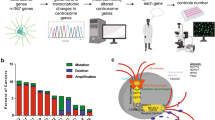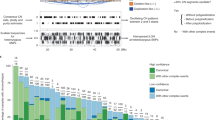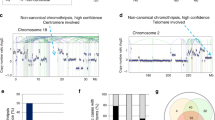Abstract
Using exome sequencing and a variant prioritization strategy that focuses on loss-of-function variants, we identified biallelic, loss-of-function CEP57 mutations as a cause of constitutional mosaic aneuploidies. CEP57 is a centrosomal protein and is involved in nucleating and stabilizing microtubules. Our findings indicate that these and/or additional functions of CEP57 are crucial for maintaining correct chromosomal number during cell division.
This is a preview of subscription content, access via your institution
Access options
Subscribe to this journal
Receive 12 print issues and online access
$209.00 per year
only $17.42 per issue
Buy this article
- Purchase on Springer Link
- Instant access to full article PDF
Prices may be subject to local taxes which are calculated during checkout

Similar content being viewed by others
Accession codes
References
Holland, A.J. et al. Nat. Rev. Mol. Cell Biol. 10, 478–487 (2009).
Torres, E.M. et al. Genetics 179, 737–746 (2008).
García-Castillo, H. et al. Am. J. Med. Genet. A. 146A, 1687–1695 (2008).
Hanks, S. et al. Nat. Genet. 36, 1159–1161 (2004).
Andersen, J.S. et al. Nature 426, 570–574 (2003).
Momotani, K. et al. Biochem. J. 412, 265–273 (2008).
Lane, A.H. et al. Am. J. Med. Genet. 110, 273–277 (2002).
Meunier, S. et al. Traffic 10, 1765–1772 (2009).
Musacchio, A. et al. Nat. Rev. Mol. Cell Biol. 8, 379–393 (2007).
Suijkerbuijk, S.J. et al. Cancer Res. 70, 4891–4900 (2010).
Forbes, S.A. et al. Nucleic Acids Res. 38, D652–D657 (2010).
Ng, S.B. et al. Hum. Mol. Genet. 19, R119–R124 (2010).
Ng, S.B. et al. Nat. Genet. 42, 790–793 (2010).
Acknowledgements
We are very grateful to all the families that participated in this study and to A. Zachariou, M. Warren-Perry, R. Linger, D. Dudakia and J. Bull for assistance in their recruitment. We thank D. Leongamornlert for assistance with exome sequencing, A. Renwick, S. Seal, G. Bowden, D. Hughes and C. Turnbull for assistance in Solexa optimization and validation experiments and B. Ebbs for DNA extraction and for running the ABI sequencer. We thank K. Tatton-Brown for assistance with clinical review of cases, A.I. Vasquez and J. Swansbury for the karyotyping and A. Strydom for secretarial assistance with the manuscript. K.S. is supported by the Michael and Betty Kadoorie Cancer Genetics Research Programme. We acknowledge NHS funding to the National Institute for Health Research Biomedical Research Centre. This work was supported by Cancer Research UK (grants C8620_A9024 and C8620_A8857) and the Institute of Cancer Research (UK).
Author information
Authors and Affiliations
Contributions
S.H., J.D. and A.M. performed exome sequencing. K.S., E.R., A.E. and N.R. performed data management and analysis. S.H. and J.D. performed CEP57 mutation and dosage analysis. P.B.-N., A.H.L., N.S., P.C., D.C., J.C.-S., D.R.F., D.G., S.J., K.A.-H., M.A.M., J.T., P.D.T. and M.W. provided clinical material. N.R. wrote the manuscript with substantial input from K.S., S.H., E.R. and J.D. N.R. designed and oversaw all aspects of the study.
Corresponding author
Ethics declarations
Competing interests
The authors declare no competing financial interests.
Supplementary information
Supplementary Text and Figures
Supplementary Methods, Supplementary Tables 1–5 and Supplementary Figures 1–4. (PDF 3220 kb)
Rights and permissions
About this article
Cite this article
Snape, K., Hanks, S., Ruark, E. et al. Mutations in CEP57 cause mosaic variegated aneuploidy syndrome. Nat Genet 43, 527–529 (2011). https://doi.org/10.1038/ng.822
Received:
Accepted:
Published:
Issue Date:
DOI: https://doi.org/10.1038/ng.822
This article is cited by
-
Effects of aneuploidy on cell behaviour and function
Nature Reviews Molecular Cell Biology (2022)
-
The Cep57-pericentrin module organizes PCM expansion and centriole engagement
Nature Communications (2019)
-
Chromosomal instability-induced senescence potentiates cell non-autonomous tumourigenic effects
Oncogenesis (2018)
-
Cep57 is a Mis12-interacting kinetochore protein involved in kinetochore targeting of Mad1–Mad2
Nature Communications (2016)
-
Aneuploidy and chromosomal instability in cancer: a jackpot to chaos
Cell Division (2015)



